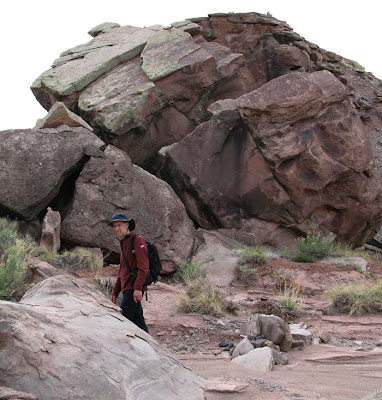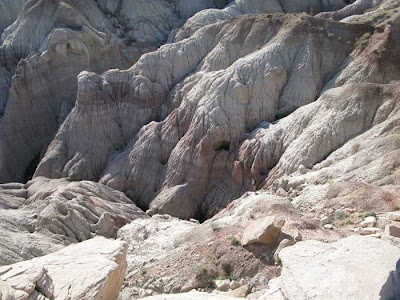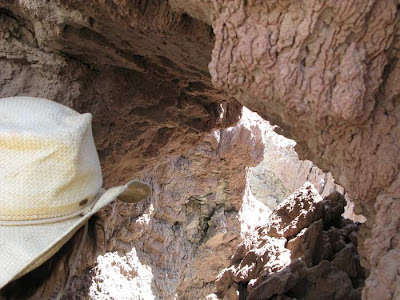




"The sun's up" said John, as I emerged from a surprisingly deep sleep on the rickety bed with its slanted headboard and too soft mattress. "Drat", I said. I was determined to see the sun rise everyday, and now this one had beaten me by about 10 minutes. This little adobe house has a luxury I don't think anyone else here has, a clear view out the front windows of the sunrise over the painted desert from the common room, or from the kitchen as I make my morning coffee. Out the back window, or better yet, from the stone terrace of its currently unoccupied twin next door, I can see the sunset and the desert formations glowing in the fading light.
The last of our mega hikes is planned for today, John's last full day here. We are going to return to the northern wilderness area and head in a different direction to see what we would find. At 7:30am, an hour later than our hike on Wednesday we start down the trail.
From Kachina Point at the PDI, which overlooks the wilderness area, we had mapped out our route. First straight east, then turning north and following a line of red badlands monuments towards a white area. It seems so clear from above, but once on the desert floor everything changes. A straight line is impossible, the easiest route is often going around or backwards. A sharp drop off proves, once you have walked to the edge, to have a series of smooths ramps down. A flat area suddenly ends in a cliff of capstone, forcing retreat and a way around. A dry wash provides easy walking despite its serpentine path, until it meanders off in the wrong direction.
My left knee, which had been giving me trouble from time to time, was now beginning to ache pretty constantly.
A year ago I had surgery on the right for a torn meniscus and had been a bit dissatisfied with the results. Now I appreciate how well it feels compared to my left. I suspect I have torn my other menicus and am trying to go easy on it (getting older means finding out more than you want to know about body parts you didn't even know you had). This is frustrating as John nimbly makes his way through the obstacle course and I, wimpily, seek out the less challenging routes.
But as we walk across the desert, over rocks, dry washes, small buttes, clay and red sand I realize we make a good team. John's eyes are looking to the distance, planning our route. Mine are, as usual, beachcombing, noticing the minutiae. Flowers springing up from bare mud. A Darkling Beetle tipping off balance as he runs away. Pronghorn tracks, or maybe deer (but that wouldn't be as fun), in the dried mud. A piece of clear quartz embedded in the side of the wash. Saltbush seedlings. The tracks of a little creature.

We reach the large formations where we turn north and skirt their base, dipping in to explore interesting caves along the way. The wall ends at Lithodendron Wash where the vegetation grows unusually tall. Banks of shale that had split in cubist style are softened at the curve where the water sometimes rushes by. John decides to explore our options as I take advantage of the seating offered by the squared off rocks and pull out my watercolor kit. He comes back before I have gotten too far though, and we set off over powdery red dunes, anchored by grasses and punctured by subterranean habitats of mouse or snake.
Here and there lay huge petrified logs, amazing in their detail.
When we reach our destination, the white place, it is a surreal landscape. Hoodoos and formations look like they have been spray painted white.
As always, I check out the drainages. These are crunchy ones, white on the bottom with crusty red topping. Eventually they narrow as to be impassable.
We agree that this moonscape had capped our hike, and start back, this time following Lithodendron Wash and its tributaries back to the trailhead. We had hiked for 5 1/2 hours, an hour shorter and longer distance than the last hike in the wilderness. It was good to get home and take off the hiking boots.
• • •
After I had showered and John was taking his, I'm working at my desk and hear a small thump. I look over and see a chubby mouse with a short tail and let out a small yelp. In my defense, he is just as startled as I am, and runs under the couch. We we first moved in we had noticed mouse droppings on the top of the fridge (how DID they get up there?) so were already storing most of the food inside the fridge, but we will have to be more vigilant. Otherwise, I'm sure I can share quarters with him for a couple of weeks.
It is still rather early, so I decide to go to headquarters to do my laundry, gas up the car for the long drive to Phoenix and chat with some rangers. Then after a dinner of rice and beans we drive to the southern end and the Tepees to see how they look in the evening light, and give John one more look before he leaves in the morning.





















































